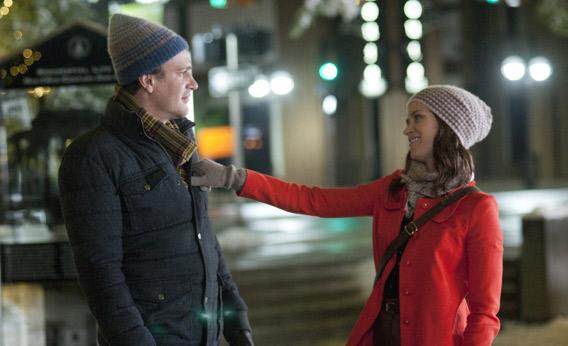The Five-Year Engagement
Jason Segel and Emily Blunt balance romance and career in an amiable if underachieving Apatovian comedy.

Glen Wilson. Universal Studios 2012.
Click on the audio player below to listen to Slate's Spoiler Special podcast on The Five-Year Engagement after you've seen the movie.
The Five-Year Engagement, directed by Nicholas Stoller and co-written by Stoller and the film’s star Jason Segel, is like the square older cousin of the 2008 Stoller/Segel collaboration Forgetting Sarah Marshall. The two films have in common a structural formlessness which, in Sarah Marshall’s case, felt freewheeling and fun: When the boy-gets-girl plot would suddenly pause for a music-video parody or a number from a puppet musical, it was all part of the movie’s loosey-goosey charm. But The Five Year Engagement has all the formlessness with half the fun. Where Forgetting Sarah Marshall frolicked on the beach, this amiable but underachieving comedy just sort of blobs on the couch.
Perhaps this lack of direction is appropriate in a movie that’s about both romantic and professional inertia. Tom (Jason Segel) and Violet (Emily Blunt) are a young San Francisco couple who are just getting engaged as the movie begins: He’s an ambitious sous-chef at a trendy restaurant, she’s an aspiring psych professor. Soon after the engagement, Violet’s dream of getting a teaching position at Berkeley falls through; instead, she’s offered a postdoc fellowship at the University of Michigan. The Ann Arbor chamber of commerce should sue this film’s producers for implying that that their cosmopolitan college town is an haute-cuisine-deprived backwater where a chef with Tom’s experience would be reduced to serving sandwiches at a deli (even if that deli is the legendary Zingerman’s).
In Michigan, Violet experiences a professional blossoming: She’s thrilled with her adviser (Rhys Ifans) and her fellow postdocs, even though, as played by Mindy Kaling, Randall Park, and Kevin Hart, they seem more like lovable crackpots than stimulating colleagues. But in a slacker spin on A Star Is Born, Violet’s career is rising even as Tom’s falls. Underemployed and depressed, he grows hideous frontier-man sideburns and takes to hunting game with a similarly emasculated faculty spouse (Chris Parnell).
Most of the film’s best moments come in this middle section, as we watch the couple deal with the strain and anxiety of deciding whose needs should be put first, and for how long. Unlike many obstacles in romantic-comedy plots, this is one a lot of real people have experienced, and at its sharpest, the script can be quite perceptive about the passive-aggressive politics of conjugal compromise. A scene with the couple fighting in bed perfectly illustrates the martyr dynamic at work: “I want to be alone,” Tom tells Violet furiously, only to insist that she come back in the room and bear witness to his anguished solitude.
Though it’s mildly raunchy in the Apatow style (he co-produced), The Five-Year Engagement, like most of the films Segel’s co-written, also allows its female characters to be recognizable human beings with senses of humor and personality traits other than niceness. Both Violet and her sister Suzie (Alison Brie) are funny, flawed, believable characters, even if the subplot of Suzie’s shotgun marriage to Tom’s best friend Alex (Chris Pratt) feels like an underwritten foil for the main couple’s story.
It’s too bad The Five-Year Engagement’s overlong, conventional last third squanders the goodwill built up in that sharply observed middle section. Without giving away too much, I can say that Tom and Violet’s relationship grows progressively rockier—culminating in the traditional third-act separation montage scored to a poignant pop song—and that, by the end, the couple’s mutual ambivalence and latent hostility are thrown to the winds as the sacredness of the marriage bond—or at least of the cloyingly cute wedding sequence—is reaffirmed.
I would have loved it if The Five-Year Engagement had had the courage to let its lead couple reunite in a tentative, provisional way, starting to trust each other again but not yet daring to pick out a font for the save-the-date cards. Instead, the denouement is so overcompensatory in its giddiness that we can’t quite believe that Violet and Tom have a shot at resolving the legitimate conflicts that tore them apart. We’re left with the sinking sense that, if this movie had a sequel, it might have to be called The Six-Year Marriage.
